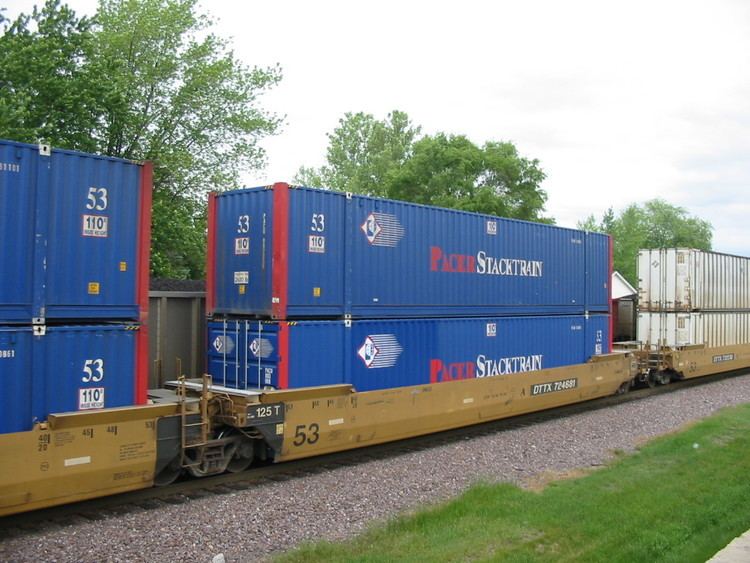 | ||
A well car, also known as a double-stack car or stack car (also well wagon), is a type of railroad car specially designed to carry intermodal containers (shipping containers) used in intermodal freight transport. The "well" is a depressed section which sits close to the rails between the wheel trucks of the car, allowing a container to be carried lower than on a traditional flatcar. This makes it possible to carry a stack of two containers per unit on railway lines (double-stack rail transport) wherever the loading gauge assures sufficient clearance. The top container is secured to the bottom container either by a bulkhead built into the car (e.g., bottom and top containers are the same dimensions of 40 ft.), or through the use of inter-box connectors (IBC). Four IBCs are needed per wellcar. In the process of an inbound train becoming an outbound train, there are four processes: unlock to unload the top container of inbound train, remove then unload bottom container, insert after loading bottom container of outbound train, lock after top container loaded.
Contents
- History
- Multiple unit cars
- Carrying capacity
- Foreign Domestic intermodal trains
- Econo Stack or Twin Stack well car
- Other countries
- Choke points
- References
Advantages to using well cars include increased stability due to the lower center of gravity of the load, lower tare weight, and in the case of articulated units, reduced slack action.
Double-stack cars are most common in North America where intermodal traffic is heavy and electrification is less widespread; thus overhead clearances are typically more manageable.
History
Southern Pacific Railroad (SP), along with Malcom McLean, came up with the idea of the first double-stack intermodal car in 1977. SP then designed the first car with ACF Industries that same year. At first it was slow to become an industry standard, then in 1984 American President Lines started working with the Thrall Company to develop a refined well car and with the Union Pacific to operate a train service using the new well cars. That same year, the first all "double stack" train left Los Angeles for South Kearny, New Jersey, under the name of "Stacktrain" rail service. Along the way the train transferred from the UP to CNW and then to Conrail.
Multiple unit cars
Each unit of a double-stack car is constructed with a single well, but are often constructed with multiple units of three to five units, connected by articulated connectors. Articulated connectors are supported by the centerplate of a single truck, (often a 125-short-ton, 112-long-ton or 113-tonne capacity truck but sometimes a 150-short-ton, 134-long-ton or 136-tonne capacity one).
Also, in a number of cases, multiple single-well cars (usually 3 or 5) are connected by drawbars and share a single reporting mark.
On both types of multiple-unit cars, the units are typically distinguished by letters, with the unit on one end being the "A" unit, and the unit on the other end being the "B" unit. Middle units are labeled starting with "C", and going up to "E" for five-unit cars starting from the "A" unit and increasing towards the "B" unit.
Carrying capacity
Double-stack cars come in a number of sizes, related to the standard sizes of the containers they are designed to carry. Well lengths of 40 ft (12.19 m), 48 ft (14.63 m) and 53 ft (16.15 m) are most common. A number of 45 ft (13.72 m) wells and 56 ft (17.07 m) wells also exist. (The sizes of wells are frequently marked in large letters on the sides of cars to assist yard workers in locating suitable equipment for freight loads.)
On 40', 45', 48', or 53 cars, larger containers (45' or up) are often placed on top of smaller containers that fit in the available wells to efficiently use all available space. All wells are also capable of carrying two 20 ft ISO containers in the bottom position.
Some double-stack cars have been also equipped with hitches which allow them to carry semi-trailers as well as containers. These are known as "all-purpose" well cars.
Foreign & Domestic intermodal trains
Foreign intermodal trains carry 20's, 40's, 45's and 53 foot containers to and from coastal container ports to import or export intercontinentally.
Domestic intermodal trains carry 53 foot containers plus trailer-on-flatcar and they travel throughout North America.
Econo Stack or Twin Stack well car
Econo Stack well cars are a variation of conventional well cars and their main purpose is to give the double stacked containers more support. The down side to them is they do not allow 53' containers to be stacked on top, but 45' containers still fit and are able to stack on top.
Other countries
Choke points
Low bridges and narrow tunnels in various locations prevent the operation of double-stack trains until costly upgrades are made. Some Class I railroad companies in the U.S. have initiated improvement programs to remove obstructions to double-stack trains. See Heartland Corridor (Norfolk Southern Railway) and National Gateway (CSX Transportation).
